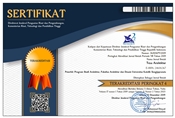ASPEK PEMILIHAN RUANG KERJA PADA HUNIAN UNTUK WORK FROM HOME (WFH) DI ERA PANDEMI COVID-19
Abstract
Abstract
A suggestion to do work at home or known as working from home/WFH has become a new habit for some of the workers in the pandemic Covid-19 era. This new habit makes publics to do some adjustments due to changes of their activities in their house, such as choosing a space to work at home. This study aims to determine what space do people choose for working and what factors and aspects that makes them choose the workspace. This study is using grounded theory approach and qualitative explorative. Data collected using online questionnaire with open-ended question and the sample is chosen with purposive sampling with the criteria people who is/was working from home. Data analysis process in three steps, such as open coding, axial coding, and selective coding. The results show that there are three architectural aspects in choosing workspace at home, such as space and physical aspects, functional aspects, and psychological aspect. This research can be applied in designing workspace at home especially in this pandemic era.
Keywords: room module, working, WFH, pandemic Covid-19
Abstrak
Anjuran bekerja dari rumah atau working from home (WFH) menjadi kebiasaan baru bagi masyarakat di era pandemi Covid-19. Hal ini mendorong para pekerja melakukan penyesuaian karena adanya perubahan aktifitas pada hunian, salah satunya menentukan ruang untuk bekerja di rumah. Penelitian ini bertujuan untuk mengetahui pemilihan ruang pada hunian untuk bekerja dan aspek-aspek yang mempengaruhi pemilihan ruang tersebut. Penelitian dilakukan dengan pendekatan grounded theory dengan metode kualitatif bersifat eksploratif. Pengumpulan data dilakukan melalui kuesioner daring yang bersifat terbuka dengan pemilihan sampel secara purposive sampling dengan kriteria pekerja yang pernah atau sedang menerapkan working from home. Proses analisis data dilakukan dengan tiga tahap yaitu open coding, axial coding, dan selective coding. Temuan menunjukkan ada tiga aspek arsitektural dalam pemilihan ruang untuk bekerja di hunian, antara lain aspek spasial dan fisik, aspek fungsional, dan aspek psikologis. Diharapkan penelitian ini dapat digunakan sebagai referensi praktisi arsitektur dalam merancang ruang kerja pada hunian di era pandemi.
Kata kunci: aspek, ruang kerja, working from home, pandemi
Keywords
Full Text:
PDF (Bahasa Indonesia)References
Ariyani, I. (2020). Penyesuaian Setting Ruang Untuk Bekerja Dari Rumah pada Masa Pandemi Covid-19. Jurnal Pengetahuan & Perancangan Desain Interior, 8(1), 9–22.
Budhiekusuma, N. P., Hadi, S. P., & Winarno, W. W. (2017). Peluang Pemanfaatan Telecommuting dalam Pemerintahan di Indonesia. Jurnal Pekommas, 2(2), 151–160.
Charmaz, K. (2006). Constructing Grounded Theory: A Practical Guide Through Qualitative Analysis. In SAGE Publications. SAGE Publications.
Cresswell, MJ. (2017). Logics and Language, Routledge.
Fivanda, & Ismanto, A. (2021). Analisis Pengaruh Konsep Interior Ruang Kerja Di Rumah Tinggal Pasca Pandemi Covid-19. Jurnal Muara Ilmu Sosial, Humaniora, Dan Seni, 5(1), 251–260.
Fraenkel, J. R., Wallen, N. E., & Hyun, H. H. (2012). How To Design And Evaluate Research in Education (8th Edition). McGraw-Hill.
Hakimah, Y., Abdie, B., Hasanah, U., jurusan manajemen, D., & Tridinanti Sumatera Selatan, U. (2021). Pengaruh Lingkungan Kerja Dan Work Form Home Terhadap Kinerja Pegawai Badan Pemeriksa Keuangan Provinsi Sumatera Selatan Di Masa Pandemi Covid-19. Jurnal Kompetitif, 10(2), 51–57.
Hanom, I., Rozefy, R. A., & Filasta, H. T. (2020). The Influence Of Ergonomic On Working From Home Activities. Idealog: Ide Dan Dialog Desain Indonesia, 5(1), 58.
Hyrkkänen, U., Nenonen, S., & Kojo, I. (2012). The Virtual Reality of Work-How to Create a Workplace that Enhances Well-Being for a Mobile Employee.
Kartika, L., Jayawinangun, R., & Indrawan, R. D. (2021). Efektivitas Program Work from Home (WFH) Berbasis Outcome Masa Pandemi Covid-19. Journal of Applied Business and Economics (JABE), 7(3), 338–356.
Kusumaningrum, A., & Martiningrum, I. (2017). Persepsi Pengunjung terhadap Tingkat Kenyamanan Bangunan Pelayanan Kesehatan (Studi Kasus RSIA Melati Husada Kota Malang). Jurnal Arsitektur Universitas Brawijaya, 5(4).
Mungkasa, O. (2020). Bekerja dari Rumah (Working From Home/WFH): Menuju Tatanan Baru Era Pandemi COVID 19. The Indonesian Journal of Development Planning, 4(2), 2020.
Mustajab, D., Bauw, A., Rasyid, A., Irawan, A., Akbar, M. A., & Hamid, M. A. (2020). Fenomena Bekerja dari Rumah sebagai Upaya Mencegah Serangan COVID-19 dan Dampaknya terhadap Produktifitas Kerja. The International Journal of Applied Business, 4(1), 13–21.
Stadtlander, L., Lacivita, L., Sickel, A. E., & Giles, M. J. (2017). Home as Workplace: A Qualitative Case Study of Online Faculty Using Photovoice. Journal of Educational Research and Practice, 7(1), 45–49.
Corbin, J. M., & Strauss, A. (1990). Grounded theory research: Procedures, canons, and evaluative criteria. Qualitative sociology, 13(1), 3-21.
Veal, A. J. (2019). Joffre Dumazedier and the definition of leisure. Loisir et Societe, 42(2), 187–200.
Wardana, J. E., Dewi, O. C., & Sari, J. S. (2021). Comfortable Room Condition for Working and Resting. Journal of Architectural Design and Urbanism, 3(2), 59–71.
DOI: https://doi.org/10.24167/tesa.v20i1.4717
ISSN 1410-6094 (Print) | ISSN 2460-6367 (Media Online) | View My Stats

This work is licensed under a Creative Commons Attribution 4.0 International License.









